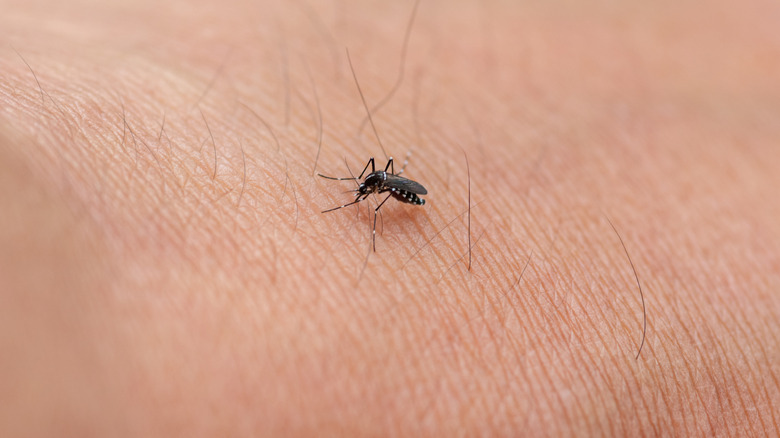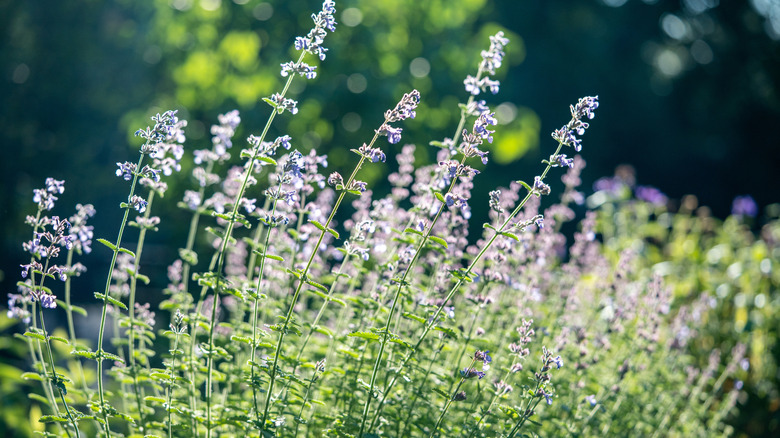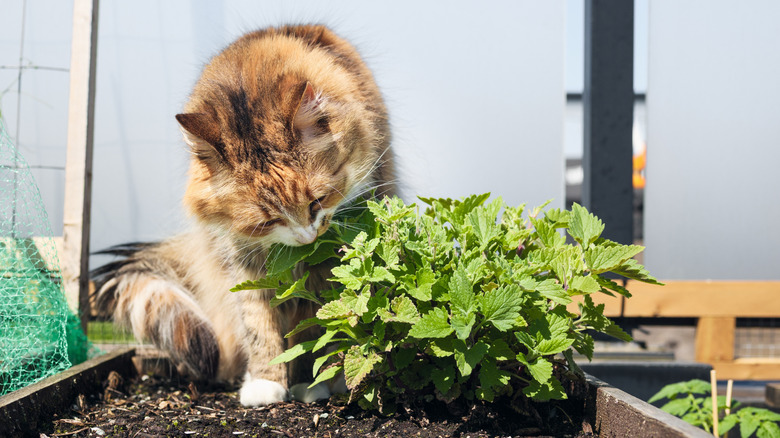The Easy-To-Grow Herb That'll Pull Double Duty As A Mosquito Repellent In Your Yard
Warmer weather and mosquitoes often go hand in hand, which can make outdoor activities unpleasant at times for your family and guests. Insect repellents are among the measures recommended by the Centers for Disease Control and Prevention (CDC) for protecting yourself from diseases transmitted by mosquitoes, but there are other measures you can take, too. For example, you may have considered using DIY mosquito traps and repellents to try around your home and garden instead of commercial products. Another idea involves planting certain plants around your yard that mosquitoes purportedly do not like, including catnip (Nepeta cataria).
Mosquitoes are drawn to certain scents around your yard, including items that are fruity or sweet-smelling. On the flipside, these pesky insects dislike acidic, pungent, or citrusy scents, which means they might be less apt to hang out around plants with these odors. It turns out that catnip may be among the mosquito repellent plants that actually work alongside other mosquito control measures you have in your yard. As a bonus, if you have a cat, they will certainly appreciate occasional cuts of foliage you can provide them with. Catnip can also add visual interest to any yard thanks to its greenish heart-shaped leaves along with pretty small flowers of varying pinks and purples that may bloom between spring and fall that attract certain pollinating species, such as butterflies. Know that planting catnip might add some mosquito protection around your yard, but it may not prevent mosquito bites entirely.
The science and limitations behind catnip as a mosquito repellent
Catnip is known for its strong-scented leaves that are more on the pungent side, and some people even describe the odor as a bit skunk-like. This plant belongs to the mint family, which happens to be a group of plants that mosquitoes do not like more generally thanks to their aromas. Catnip in particular contains an oil in its leaves called nepetalactone. Interestingly, previous research reported by Science Daily in 2001 noted that this oil may be up to 10 times stronger than commercial DEET in terms of mosquito repelling effects. More recently, a 2019 study in Scientific Reports found that nepetalactone had a 95% efficacy rate against mosquito activity for up to four hours. The big caveat here with the research on catnip thus far is that the oils were compared to commercial products when applied to human skin. Research regarding planting catnip plants around yards as mosquito control is generally lacking.
As another caveat here, be aware that catnip flowers may also attract bees, flies, and wasps. While the flowers can be beneficial to these types of flying insects, you could inadvertently be inviting another problem for your yard if you have flowering catnip surrounding your family. You can create a balance here by planting catnip in planters, so that you can easily transport it around your yard. If the plants are flowering, you can keep any flying insects away from your family and guests by placing the containers further away from your activities. Pruning is another solution if catnip is attracting unwanted insects.
Tips for growing catnip for natural mosquito control
Before you commit to adding mosquito-repelling plants to your yard, it's important to learn how to successfully grow a catnip plant. First, despite how easy they are to grow, know that these herbal plants do best in USDA hardiness zones 3 to 9. Catnip also prefers full sun and well-draining soil, but it's considered drought-tolerant, too. The plant also doesn't need much maintenance once it's established.
The plant grows relatively quickly, which can be beneficial during mosquito season. Just be aware that it can get up to 2 to 3 feet tall. Like other members of the mint family, it can also spread rapidly and take over your garden. With this in mind, you'll want to pick spots in your yard that have enough space to accommodate catnip in the ground, or you can consider container-growing catnip instead. When choosing the latter method, pick containers that are 10 inches deep or more so the herb has enough space to grow.
Also, if you do happen to have a cat, or if there are cats that roam your neighborhood, know that they will likely take a strong liking to any catnip you plant in your yard. As such, you will want to take steps to control how much of the foliage they can access, especially in smaller plants that have not yet been established. Otherwise, your catnip might be destroyed before you ever get a chance to experience its full mosquito-repelling potential. One idea is to surround the plant with small cages for protection against curious felines until the catnip has a chance to grow larger.


